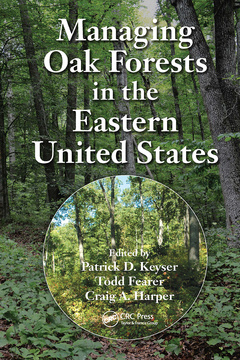Managing Oak Forests in the Eastern United States
Coordonnateurs : Keyser Patrick D., Fearer Todd, Harper Craig A.

If you are responsible for oak management, Managing Oak Forests in the Eastern United States is for you. It is the definitive practical guide for anyone interested in improving stewardship of eastern oak forests.
Organized into three sections, the first section, "Background and Biology: Setting the Stage," helps you establish a solid understanding of the history and ecology of eastern oak ecosystems. It examines the question "Why do we manage oaks?" and looks at some of the challenges faced in oak management such as fire, wildlife management, and oak regeneration. It also provides a description and distribution of oak forests across the eastern United States and discusses the biology of oaks.
The second section, "Silviculture: What Is in the Tool Box," gives you a practical understanding of how management can be implemented in eastern oak forests. It covers natural regeneration, artificial regeneration, and use of prescribed fires, competition control, and intermediate treatments.
The third and final section, "Managing Oaks: How Do I Make It Work for Me?" helps you clarify your objectives and chart a course to bring about the desired outcomes for the forests you are managing. This section assists you in evaluating your progress in managing your oaks and what changes you will need to make. It provides details on management objectives for upland oaks, woodlands and savannahs, and bottomland oaks. It also gives you guidance on managing deer impacts on oak forests. The last chapter is specifically designed to help you get started.
Background and Biology: Setting the Stage. Silviculture: What Is in the Tool Box? Managing Oaks: How Do I Make It Work for Me?
Patrick Keyser, PhD, is professor and director for the Center for Native Grasslands Management at the University of Tennessee (UT), Knoxville, where he has been since 2006. Prior to UT, Dr. Keyser was a senior wildlife biologist for MeadWestvaco, a global forest products company, and was based out of West Virginia. He also worked as a biologist for the Virginia Department of Game and Inland Fisheries. In all of these roles, Dr. Keyser has been actively engaged in forest management, forest and wildlife research, and working with various forest landowners (private, state, federal, and industry) to improve productivity and sustainability.
Todd Fearer, PhD, joined the Appalachian Mountains Joint Venture (AMJV) in 2010 as the science coordinator, and became coordinator in 2012. Prior to working with the AMJV, he was an assistant professor at the University of Arkansas’ School of Forest Resources. He received his BS in wildlife and fisheries science with minors in forest science and international agriculture from Penn State University. He then went on to obtain both his MS and PhD in wildlife science from Virginia Tech, conducting research as part of the Appalachian Cooperative Grouse Research Project and evaluating population–habitat relationships of forest breeding birds at multiple spatial and temporal scales, respectively.
Craig A. Harper, PhD, is a professor of wildlife management and the extension wildlife specialist at the University of Tennessee, where he develops wildlife management programs for UT Extension and assists natural resource professionals with issues concerning land management for wildlife across the eastern United States. Dr. Harper maintains an active research program that specializes in upland habitat management, including the effects of silviculture, prescribed fire, and herbicide applications on habitat for various wildlife species. Dr. Harper is a C
Date de parution : 06-2021
15.6x23.4 cm
Date de parution : 01-2016
15.6x23.4 cm
Thèmes de Managing Oak Forests in the Eastern United States :
Mots-clés :
Oak Seedlings; Northern Red Oak; disturbance ecology/ecological stress/ecosystem health; Oak Regeneration; Oak silviculture; Red Maple; stewardship/conservation; Ruffed Grouse; natural resources; Yellow Poplar; Oak forests; Oak Forest; Oak ecosystems; Oak Species; Forest management; Scarlet Oak; Hardwood management; Stump Sprouts; Oaks and wildlife management; Southern Red Oak; Oak woodlands and savannahs; Chestnut Oak; Oaks and prescribed fire; Oak Savannahs; White Oak; Red Oak; American Beech; Hardwood Stands; Red Oak Group; White Tailed Deer; Bottomland Hardwoods; Overcup Oak; Oak Reproduction; Oak Plantings; Swamp White Oaks; Eastern Towhee



